This July, we returned to one of our favorite places on Earth: the Pantanal. It’s the kind of place where wildlife feels like it’s spilling out of the forest and into your lap. From above, below, and all around—there is life. The Pantanal is a living, breathing example of conservation and coexistence at its best, and one of the clearest success stories in ecotourism.
Our jaguars of the Pantanal itinerary visits both the Northern and Southern Pantanal, exploring two very different habitats, each incredibly productive for jaguars and other wildlife.
This trip report features some photos by us, but mostly photos from a few of our guests (with their social media handles in the caption)!
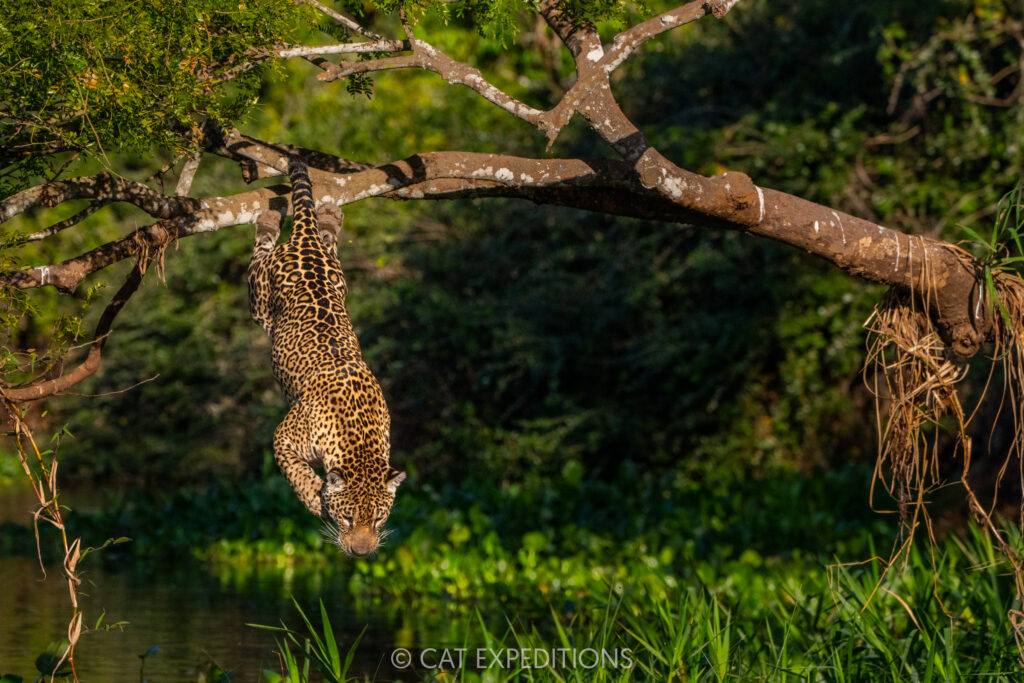
Highlights of the 2025 Jaguars of the Pantanal Photo Tour
Jaguar: 31 Jaguar Sightings (19 individuals!) – a new record for our tour. We encountered both males and females along the smaller channels of the Cuiabá River, including multiple dramatic moments with some familiar faces. Medrosa was up to her old tricks—hunting from trees, waiting for a caiman to pass underneath, and then diving spectacularly into the water. And we had a front-row seat to Ousado’s famous “submarining” behavior—watching him glide underwater like a sea lion, attempting ambushes of caiman from below. He didn’t make a kill, but the skill and stealth on display was unforgettable. For our closest jaguar encounter, we had the cat at just five meters!

Jaguar Caiman Hunt: Watching a successful river hunt is like witnessing a grand slam at the bottom of the ninth—rare, electric, and over in seconds. We were lucky enough to be the only boat with Courtney and her massive cub Rafa as they hunted through a narrow channel. After a patient stalk, Courtney launched from the riverbank and landed cleanly on a massive caiman, clamping her jaws around its head. It was fabulous. Dramatic. Impressive. And the kind of sighting we’ll all remember for a long time.

Jaguar Cub: Many of our guests had “jaguar cub” high on their wishlist. In the Southern Pantanal, we were among the first to have extended views of Aracy’s four-month-old cub, Mocoha. He was shy, but curious—and we watched as Aracy gently encouraged him to reveal himself, a beautiful testament to the careful habituation work happening in this region.

14 Mammals, Including Anteaters with Pups: Jaguars aside (just for a moment!), we saw 13 other mammals this week: three tapirs (including one spotted in a tiny river channel—our guide’s first in that location), a Marsh deer crossing the river, a playful troop of Giant River Otters, a thermal-only glimpse of an ocelot (which led to us getting thoroughly stuck in the mud), and two anteaters with pups clinging to their backs. Full mammal list at the end of this report.
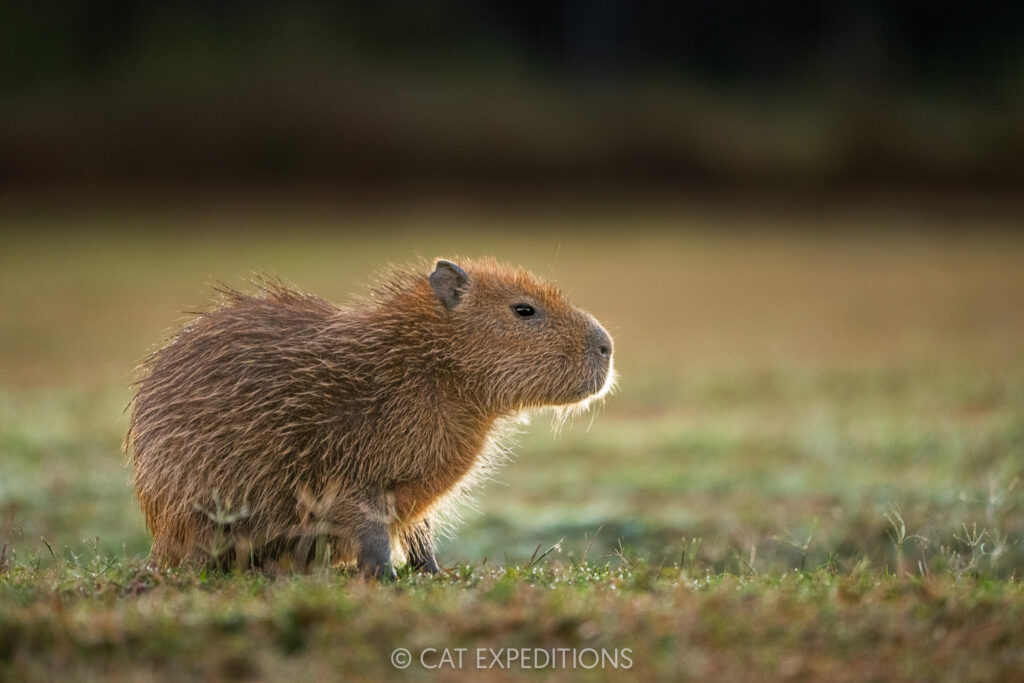
108 Bird Species: The Pantanal remains one of our favorite birding destinations. Among the group’s top highlights were several Great Potoos—spotted camouflaged in daylight, and photogenically so.

Detailed Jaguar Trip Summary 2025
Day 1: We hit the ground running—well, driving—on the iconic Transpantaneira road, heading south from Cuiabá to Porto Jofre after greeting our guests at the airport. This famously wildlife-rich dirt track slices right through the northern Pantanal, and even though we prioritized reaching our lodge in good time for a full night’s rest, the wildlife made sure we didn’t forget where we were!
By the end, we racked up an impressive list of thirty bird species, with our cameras itching to capture more. And despite keeping stops to a minimum, we had to pull over for some spectacular sightings: a line of baby caiman trailing behind their mother like a living necklace, a proud pair of Jabiru storks towering over their nest, a massive Pantanal swamp turtle with a truly oversized noggin, a sleek false water snake, and—maybe the crowd favorite—a totally chill pair of crab-eating foxes lounging on the road as if expecting us.
By the time we arrived at Porto Jofre and sat down for our welcome dinner, the excitement was already buzzing. If this is what the Pantanal offered on the way in, what could tomorrow possibly bring? We were ready to find out.
Day 2: Cool mornings greeted us—low 60s before the sun climbed high. Within minutes of launching, we got a radio call: a tapir, feeding along the riverbank. A first for us and our guide in this stretch of the river. Not long after, the jaguar floodgates opened.
- Marcela swimming in the channel
- Patricia (Marcela’s grandmother) hunting with a fresh gash on her face—possibly from a recent skirmish.
- Saseka, a gorgeous 4–5-year-old female, snoozing on the riverbank.
- Borroro, zig-zagging from one channel to another, hunting.
- Ousado, the star of the day, made three dramatic submarine-style hunting attempts—none successful, but mesmerizing to watch. (This is a new behavior he has developed after he recovered from recent wildfires, and the same behavior is spreading to other jags in the area!)
- Siriri, spotted by our guest Ona, appearing briefly before vanishing into the forest.
Also seen: Giant River Otters playing, a yellow anaconda napping in a riverbank cavity, green iguana, capybaras. Total for the day: 8 individual jaguars and 9 sightings. Not bad for a Tuesday.
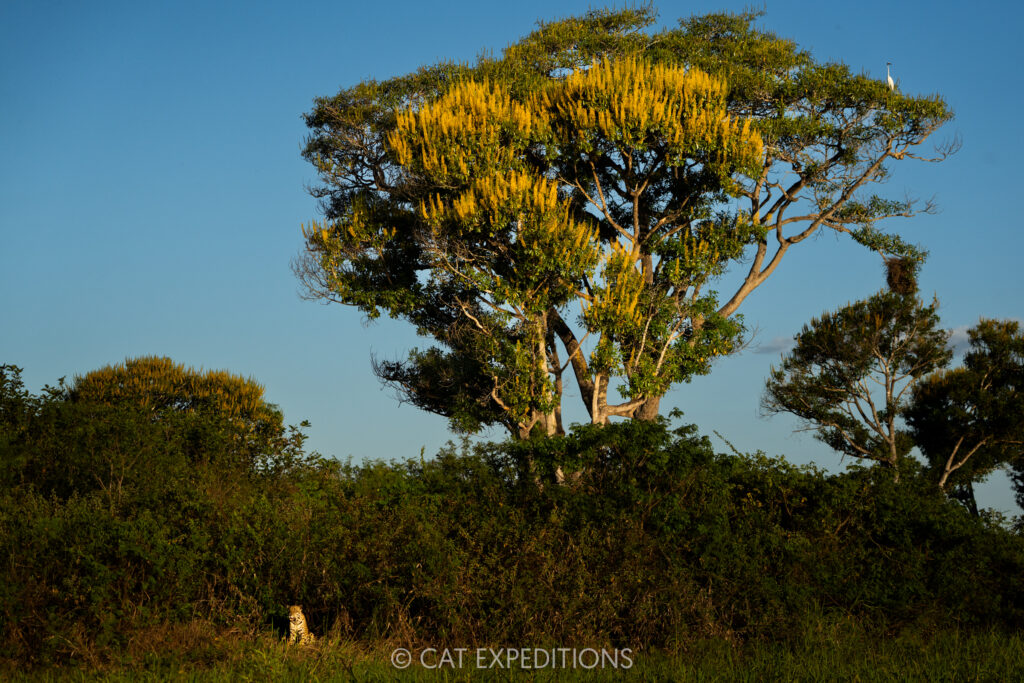
Day 3: It was still dark when Sebastian spotted our first jaguar of the day—Tango—using his thermal binoculars. We watched him lounge on the riverbank for a few quiet moments before he slipped away into the early morning shadows.
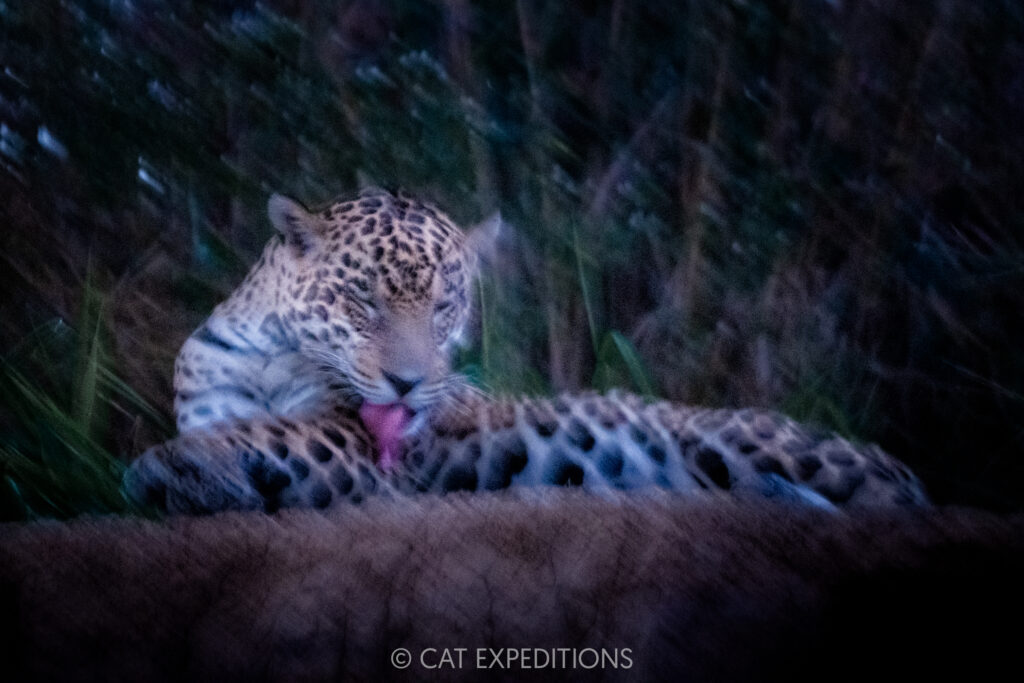
Later that morning, we returned to the Carixo Negro, where we found Medrosa doing what she does best: hunting patiently from the trees. No heroic leap today, but we had a wonderful stretch of time with her draped elegantly in the tree, until she eventually climbed down, chewed lazily on some grass, and settled along the bank in the shade.
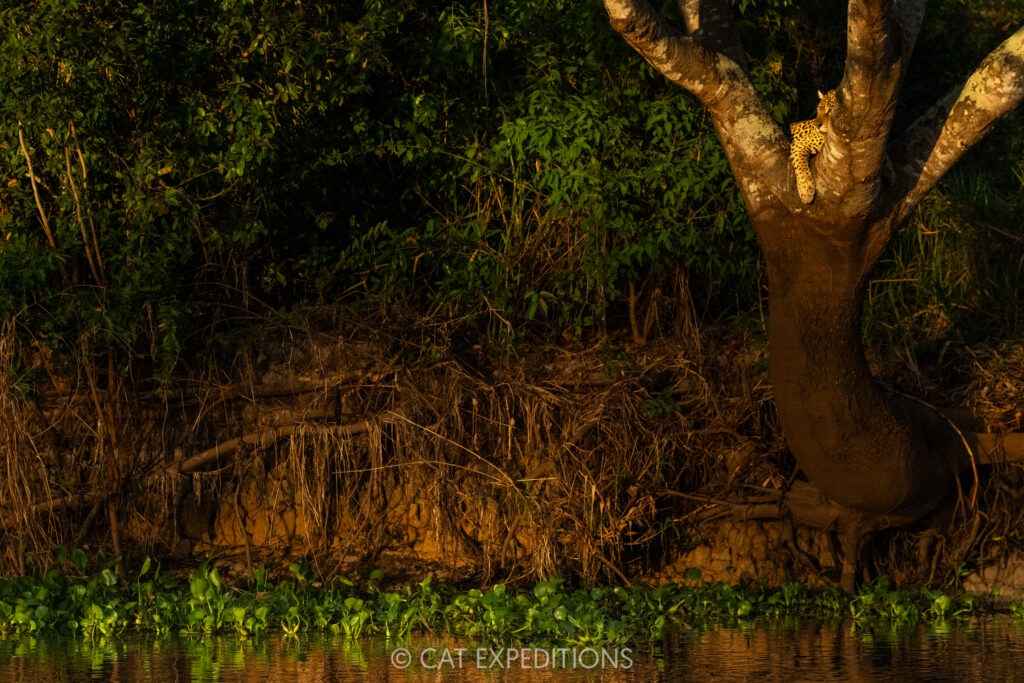
The rest of the morning brought a lovely mix of sightings—Howler Monkeys calling from the canopy, a caiman carcass being picked apart by vultures, a Toco toucan being chased by a trio of kiskadees, a noisy colony of Large-billed terns, and a pair of Capybaras lounging contentedly on a small sandy beach.
That afternoon, we added a few more species to our growing mammal list, including a group of Azara’s Capuchin Monkeys, and interestingly, a Marsh Deer swimming across the river, which was a first for all of us.
We got a radio call about Ousado, but by the time we arrived, he had already disappeared. Later on, we managed a quick glimpse before he vanished again. The day ended with a lovely sighting of a Boat-billed Heron tucked into the riverbank vegetation—one of Rachel’s favorites.
That evening, we had the privilege of visiting Panthera’s research station, where Abbie from the Jaguar ID Project walked us through the work of tracking individual jaguars and the intricate art of identification. Raissa from Panthera shared updates on their ongoing conservation work, including efforts to expand protected corridors along the Cuiabá River. We were proud to contribute $1,000 from this tour to support the important work of both organizations, and left the station feeling both inspired and grateful.
Day 4: The day began, once again, with Medrosa—ever the patient predator. She was perched high in a tree above a thick patch of water hyacinth, scanning the surface below for a passing caiman. We spent the entire morning with her, watching and waiting under the rising sun as she lounged on the thick branch, eyes fixed on the water below. Though the sighting eventually drew quite a crowd, our group held strong—and two hours later, our patience was rewarded. With that unmistakable feline focus, Medrosa suddenly became alert, and after some time, launched herself from the tree in a breathtaking leap…and missed her target. Even so, it was incredible to witness her grace and commitment to the hunt. After the splash, she retreated into the vegetation, and with the midday heat building, we headed back to the lodge for lunch.
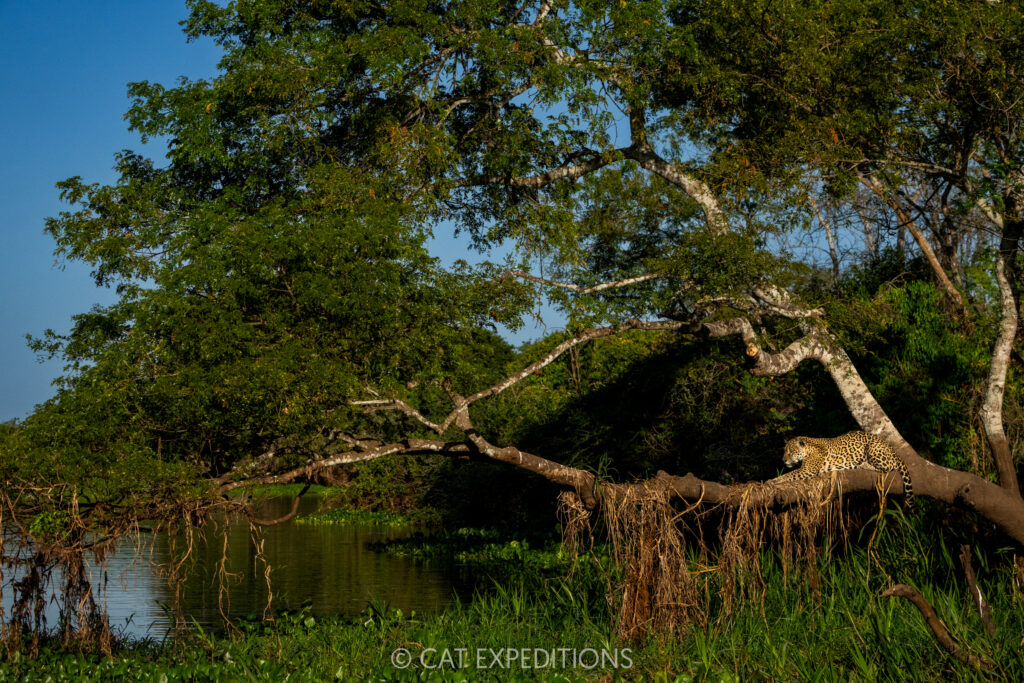

That afternoon, things were quieter on the river. We searched the banks, revisited a few promising areas, and kept our eyes peeled for movement—but the evening belonged to the birds, reptiles, and capybaras. A golden light settled over the water, and we made our way home as the sky turned pink, grateful for a morning we’ll never forget.
Day 5: We kicked off the morning on the Carixo Negro, where we had a brief encounter with Inka, a beautiful female jaguar spotted along the riverbank. Not long after, Medrosa made another appearance—this time moving from tree to tree in search of prey. No jump today, but the show of agility alone was worth the watch.
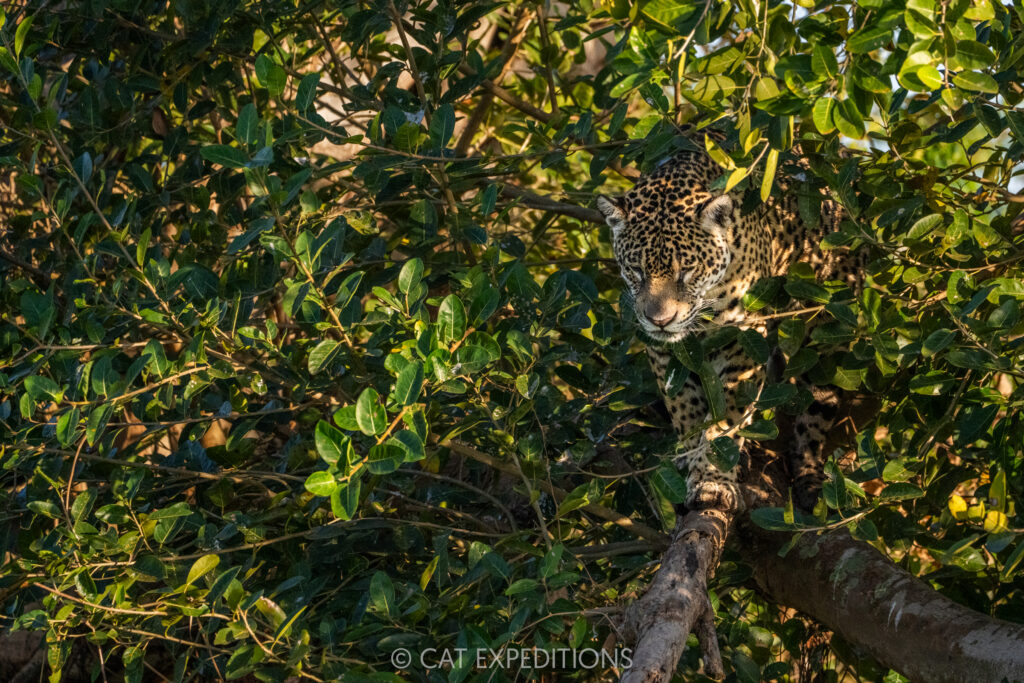
Later in the morning, our guide spotted Inka again—this time swimming. Watching a jaguar push upriver, muscles rippling with every stroke, is nothing short of astonishing. Their power and stamina in water is unlike any other big cat.
Our final jaguar of the morning was Akaloi, who we trailed for a while as he paced along the shore before vanishing back into the dense bush.
That evening, we spent nearly an hour with a family of Giant River Otters, watching them groom, play, and mark territory. The social dynamics between them—siblings squabbling, parents corralling, and lots of little squeaks—offered a wonderful interlude to the day’s jaguar focus. As the sun dipped low, we were chasing down a few radio reports, but nothing panned out—until it did. While cruising back down the Tres Irmãos, Rachel spotted a jaguar perfectly framed by the lush green vegetation. Siriri, statuesque and still. Just ten minutes later, we encountered another cat: a young male called Pantaneiro. He emerged onto the sandy riverbank, scent-marked a few bushes, and then disappeared as silently as he arrived. Two private sightings, no other boats around. A dreamy way to close out the day.
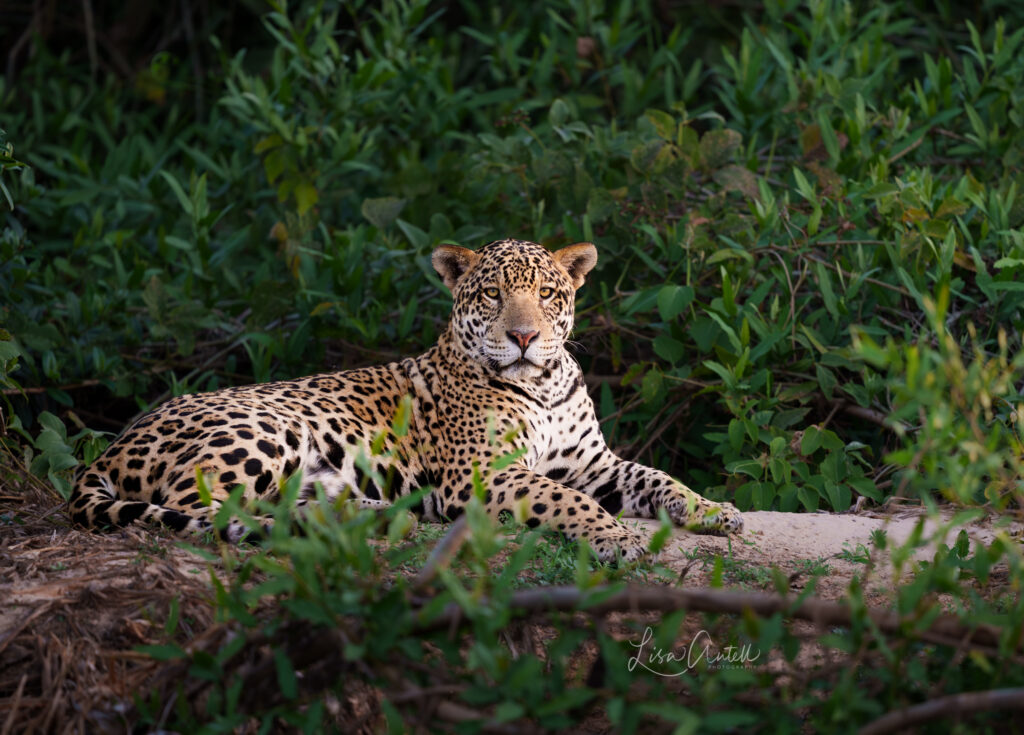
Day 6: For our final day in Porto Jofre, we decided to head upriver, making a wide loop before returning to camp to pack up and begin our journey south.
Just a few bends in, we found Donal, pawing through vegetation and then crossing the river with purpose. Shortly after, we came across Patricia and her impressive male cub, Makala—together on the riverbank, offering a rare and intimate glimpse of jaguar family life.
As we ventured further into the quiet waters of the Caixiri, we passed through serene, boat-free stretches—just us and the wildlife. A troop of Howler Monkeys called from the trees above.
Then came one of the week’s most riveting encounters. One of our guests spotted a female jaguar, who we identified as Courtney, alongside a massive male: her cub, Rafa. He’d grown into a beast of a cat, and the two moved in tandem along the riverbank, weaving across the narrow channel as they hunted. We followed them like this for over an hour.
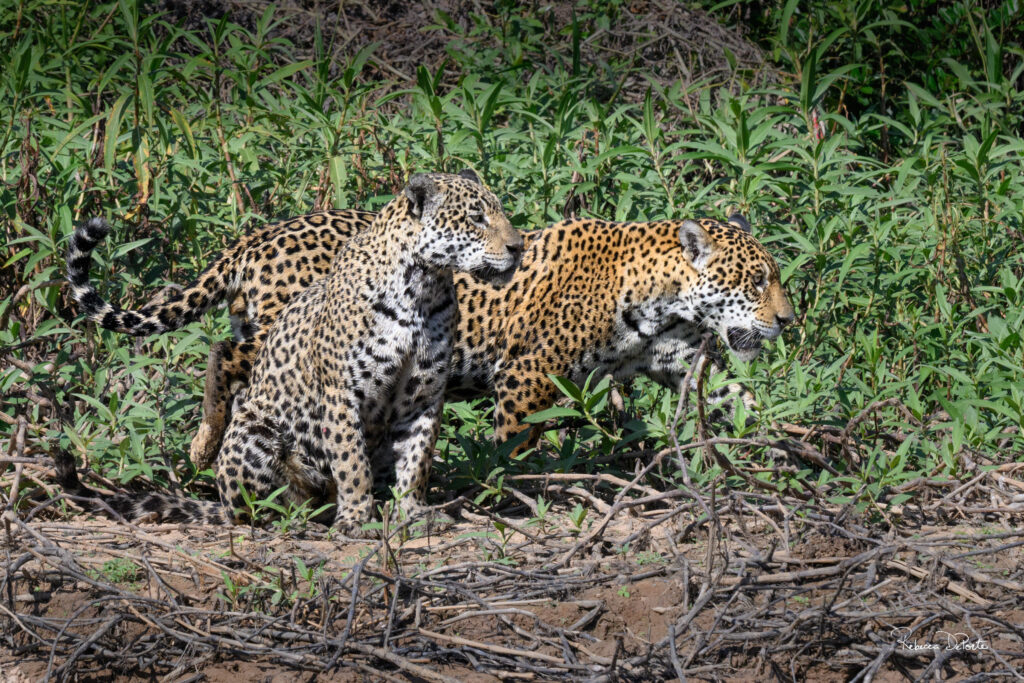
Eventually, Courtney zeroed in on a large caiman, resting on a sandbar below a steep bank. She climbed up above it, began her slow, steady stalk, and then leapt—clean and direct—onto the caiman’s head. The next few moments were a blur of water and muscle, the two animals thrashing until finally, Courtney dragged the now-limp caiman up the bank and into the vegetation.
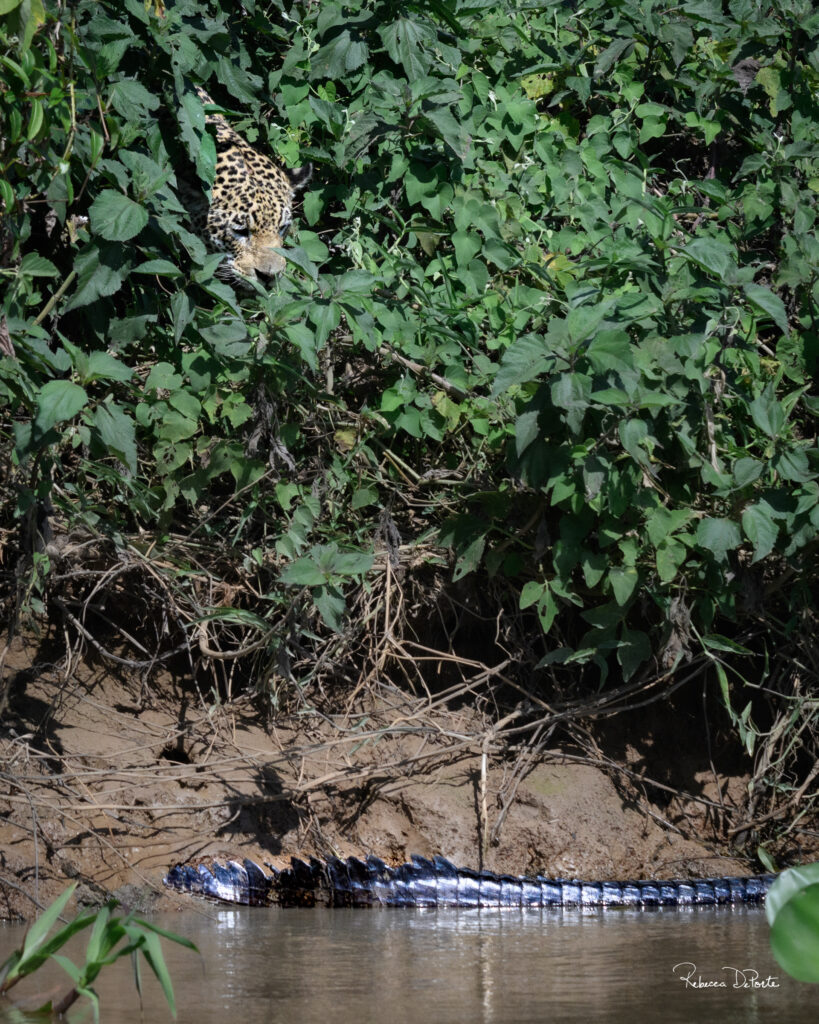
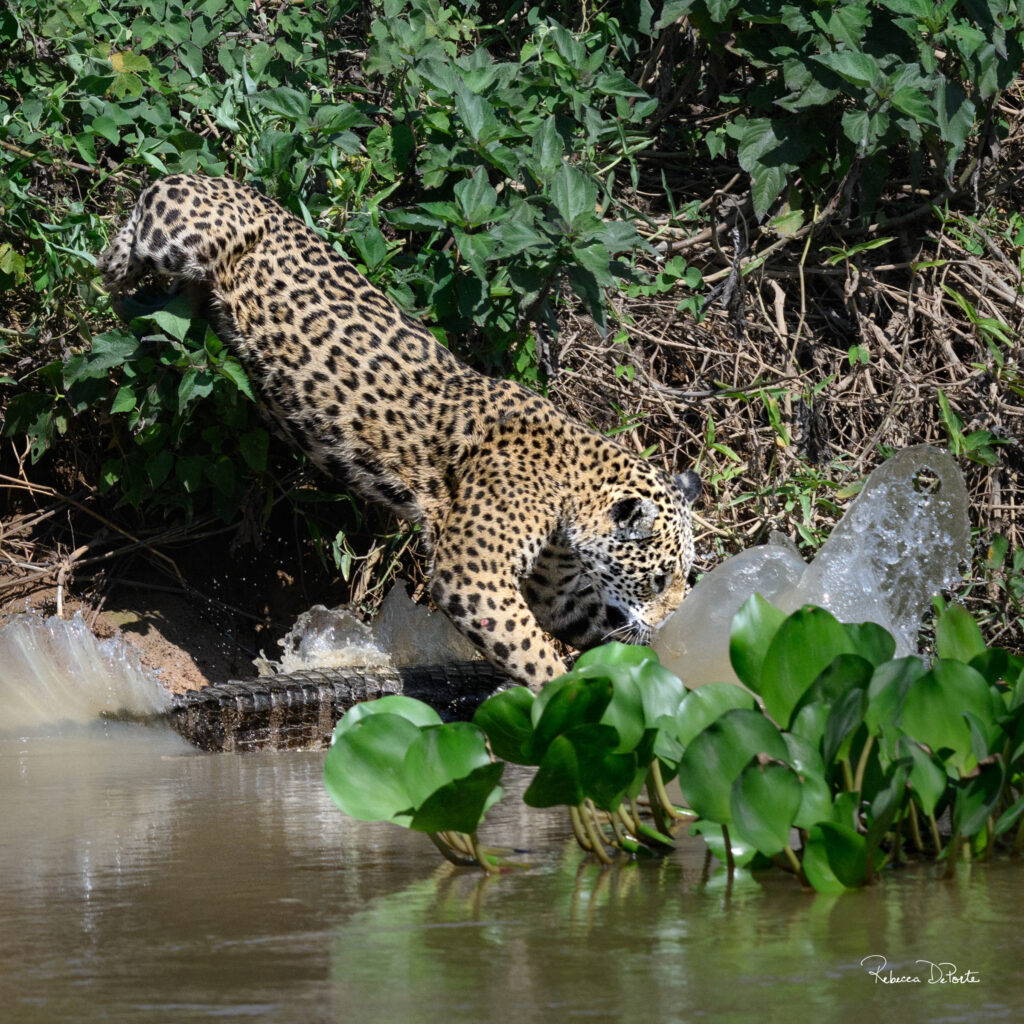
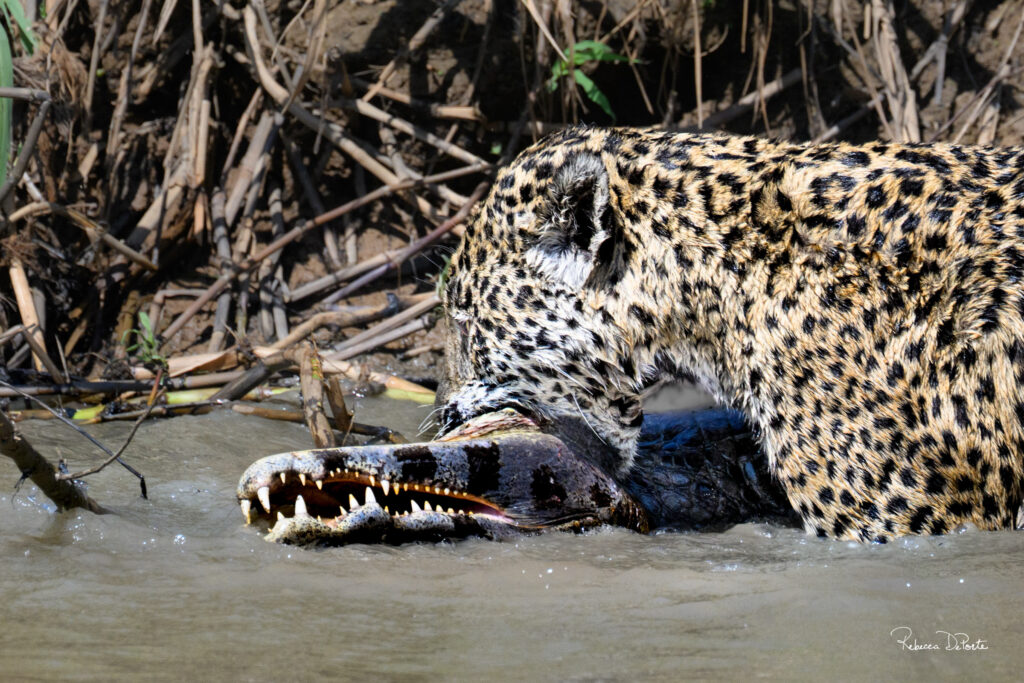
It was a masterclass in strength, precision, and wild instinct—and a phenomenal way to wrap up our time on the river.
We then met our charter flight crew at the airstrip right at the edge of our accommodation, and began our short slight south, to the Southern Pantanal. We would settle into our private accommodation, and get ready for our first night drive.
That first afternoon into evening we saw a Tegu lizard, Crab-eating foxes, Bulldog bats, many Caiman and Capybara, several Pampas deer, some Brocket Deer and a Lancehead viper.
Day 7: We spent the next several days in a new region of the Pantanal, exploring this different habitat alongside the incredible team at Onçafari, whose conservation work spans the Pantanal, Cerrado, and beyond. Their efforts to monitor, habituate, and protect jaguars (and now maned wolves, pumas, and giant anteaters too) are deeply inspiring, and it is always a privilege to learn from them in the field.
As we searched for jaguars that morning, the forest was alive with other sightings: Crab-eating foxes darting across the trail, flashes of color from Snail Kites and Vermilion Flycatchers, Capybara lounging on the shore, Howler monkeys silhouetted in the canopy, and Pampas deer grazing in the fields.
But the real gem of the morning came from Surya and her 1-year-old cub, Dakari. We found them resting deep in the forest, nestled together in the shade. Dakari was in full cub mode—rolling over, snuggling, squirming, flopping onto mom and pestering her rest. Observing behavior like this for so long reminded us just how rare and special these opportunities are. We say it every time, but it never loses meaning: to spend quiet time with wild big cats, watching their natural behaviors unfold on their terms, is an absolute privilege.

After lunch and a bit of downtime, we headed back out for an evening game drive. We got reports that Aracy had been seen near the bush dinner site, and sure enough, we found her pacing the area—doubling back and retracing her steps, possibly searching for her cub. Eventually, she slipped back into the brush.
As night fell, the sightings came in fast—but split across vehicles. One group spotted an anteater lumbering across the road. The other picked up an ocelot through the thermal scope. It had climbed into a scraggly tree out in a field, not so visible to the eye. We maneuvered off-road to get closer and promptly got very stuck in the mud. While waiting for the other car to rescue us, Rachel spotted the ocelot once more in the thermal as it descended the tree—but it melted into the darkness before we could get eyes on it.
On the way back to the lodge, we added a few more night wonders: a Great Potoo (always a joy to see their perfect camouflage) and a European Hare darting across the road.As we neared camp, headlights caught one last flash of feline—Aracy again, walking wet along the road, possibly returning to reunite with her cub after a successful (and soggy) hunt. A quiet, powerful end to another wild day.
Day 8: We began the morning with anteaters in mind, hoping to catch sight of one in the open fields while the light was still soft. Though the anteaters stayed out of view, the morning offered plenty of beauty. A loud chorus of Hyacinth macaws, Monk parakeets, and Nanday parakeets lit up the treetops, their flashes of color streaking across the sky. Campo flickers and White woodpeckers gave us some wonderful views, and a group of Capybara, perfectly backlit by the rising sun, made for some dreamy photographic moments.
That afternoon, the Onçafari team checked Aracy’s GPS collar and noticed she’d been stationary for several hours. That kind of signal often suggests a kill, so we pivoted from anteater searching and followed the lead.
When we arrived, we found Aracy stretched out in the open near a large waterhole—alone, resting. After a while, she sat up and began to call. A few moments later, we heard an answering cry from inside the bush—her cub. The calls grew more frequent, and soon, we saw him: a quick flash of fur as he peeked out, then ducked back into the undergrowth.
Eventually, Aracy stood, disappeared into the brush, and re-emerged a few minutes later—this time with her three-month-old cub in tow. (One of our guests decided to adopt this cub, and named him Mocoha.) Mocohoa was shy, keeping a constant eye on us, trying to hide behind, around, and underneath his mother. But slowly, tentatively, he began to gain confidence, lingering a bit longer in the open. After a few precious minutes, they turned and slipped back into the bush. We listened as the soft sounds of feeding confirmed our hunch from our sighting of Aracy the night before.

It was a gift of a sighting. We left them in peace to enjoy their meal.On the way back, just as we neared our special Pantaneiro-style barbecue, a Tapir crossed the path—silent, swift, and gone in a flash. A fitting end to a day full of subtle magic and wild grace.
Day 9: We set out early, retracing our path to where we’d last seen Aracy and Mocoha. The morning was cool and misty. Not long after arriving, we spotted her again—this time with the cub—resting on a small earthen berm near the road.
As the sun rose, Aracy led her cub across the road and back toward the waterhole and thicket. We caught glimpses of them weaving through the grass before they vanished into the brush. We waited, hoping for another look, and passed the time with excellent birding—Hyacinth Macaws, flickers, and more lighting up the morning.

Later, we explored the savanna in search of another female with cubs, but had no luck. A brief appearance by Surya, slipping across the road, was our parting gift before we returned to camp for a midday break.
That afternoon, one vehicle returned to Aracy’s waterhole while the other vehicle went in search of anteaters.
Those in search of jaguars circled the area she was in several times. Telemetry confirmed she was still there, but the pair remained hidden. We heard faint vocalizations, likely mother and cub calling to one another. When capybara nearby began alarm-calling, we investigated, but no predator revealed itself.
Meanwhile, the other vehicle reported two Anteaters, one with a baby on her back! Dinner was served in a glowing bush boma, strung with lanterns and full of warmth. We met Mario Haberfeld, founder of Onçafari, a former race car driver turned conservationist, whose stories reminded us of the power of passion redirected. A lovely close to a day full of subtle wonder.
Day 10: On our last morning of the trip, we decided we wanted to have one last chance at getting some good macaw flying photographs, whether Hyacinth Macaw or other species. We drove to the trees the macaws used as a roosting spot, and had a few great hours of macaw photography. Funnily enough, the highlight of the morning wasn’t Hyacinth macaws, but a pair of Yellow-collared macaws taking off against the sunrise glow.
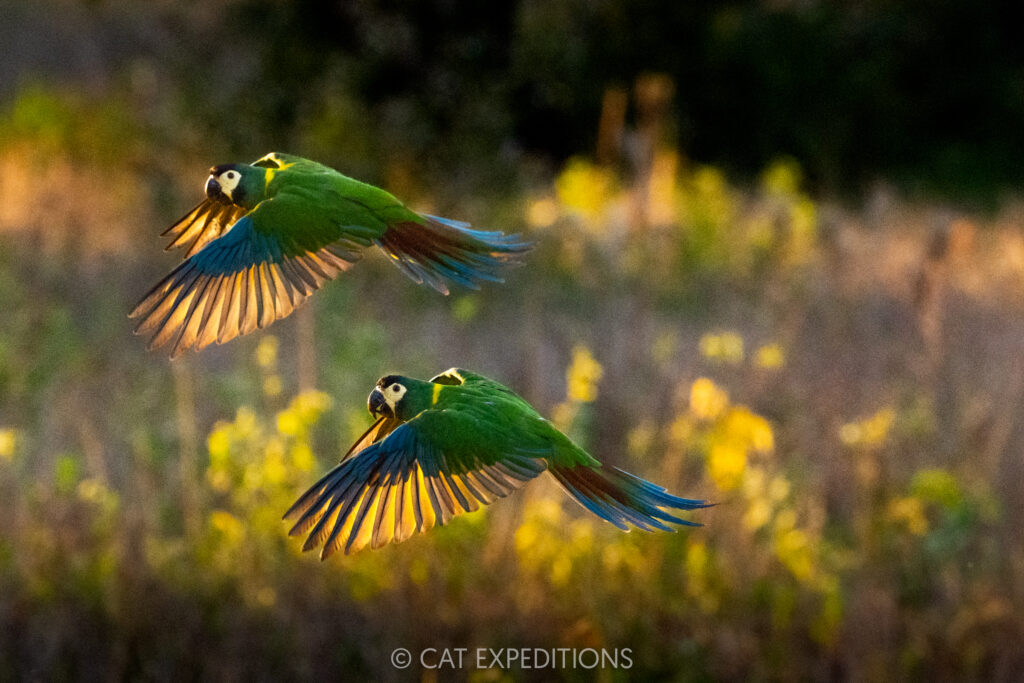
Jaguars of the Pantanal Photo Tour 2025 Species List
Mammals
| Giant Anteater | Myrmecophaga tridactyla |
| Greater Bulldog Bat | Noctilio leporinus |
| Azara’s Capuchin Monkey | Sapajus cay |
| Black Howler Monkey | Alouatta caraya |
| Crab-eating Fox | Cerdocyon thous |
| Ocelot | Leopardus pardalis |
| Jaguar | Panthera onca |
| Giant River Otter | Pteronura brasiliensis |
| Brazilian Tapir | Tapirus terrestris |
| Marsh Deer | Rucervus duvaucelii |
| Red Brocket Deer | Mazama americana |
| Gray Brocket Deer | Mazama gouazoubira |
| Pampas Deer | Ozotoceros bezoarticus |
| Capybara | Hydrochoerus hydrochaeris |
| European Hare | Lepus europaeus |
Birds
| Greater Rhea | Rhea americana |
| Southern Screamer | Chauna torquata |
| Black-Bellied Whistling Duck | Dendrocygna autumnalis |
| Muscovy Duck | Carina moschata |
| Brazilian Teal | Amazonetta brasiliensis |
| Chaco Chachalaca | Ortalis canicollis |
| Chestnut-bellied Guan | Penelope ochrogaster |
| White-throated Piping Guan | Pipile grayi |
| Blue-throated Piping Guan | Pipile cumanensis |
| Bare-faced Curassow | Crax fasciolata |
| Picazuro Pigeon | Patagioenas picazuro |
| Ruddy Ground Dove | Columbina talpacoti |
| White-tipped Dove | Leptotila verreauxi |
| Guira Cuckoo | Guira guira |
| Smooth-billed Ani | Crotophaga ani |
| Squirrel Cuckoo | Piaya cayana |
| Nacunda Nighthawk | Chordeiles nacunda |
| Band-tailed Nighthawk | Nyctiprogne leucopyga |
| Common Pauraque | Nyctidromus albicollis |
| Great Potoo | Nyctibius grandis |
| Gray-cowled Wood Rail | Aramides cajaneus |
| Limpkin | Aramus guarauna |
| Southern Lapwing | Vanellus chilensis |
| Collared Plover | Charadrius collaris |
| Wattled Jacana | Jacana jacana |
| Yellow-billed Tern | Sternula superciliaris |
| Large-billed Tern | Phaetusa simplex |
| Black Skimmer | Rynchops niger |
| Jabiru | Jabiru mycteria |
| Wood Stork | Mycteria americana |
| Anhinga | Anhinga anhinga |
| Neotropic Cormorant | Phalacrocorax brasilianus |
| Rufescent Tiger-Heron | Tigrisoma lineatum |
| Cocoi Heron | Ardea cocoi |
| Great Egret | Andrea alba |
| Snowy Egret | Egretta thula |
| Cattle Egret | Bubulcus ibis |
| Striated Heron | Butorides striata |
| Whistling Heron | Syrigma sibilatrix |
| Capped Heron | Pilherodius pileatus |
| Black-crowned Night Heron | Nycticorax nycticorax |
| Boat-billed Heron | Cochlearius cochlearius |
| Green Ibis | Mesembrinibis cayennensis |
| Bare-faced Ibis | Phimosus infuscatus |
| Plumbeous Ibis | Theristicus caerulescens |
| Buff-necked Ibis | Theristicus caudatus |
| Roseate Spoonbill | Platalea ajaja |
| Black Vulture | Coragyps atratus |
| Lesser Yellow-headed Vulture | Cathartes burrovianus |
| Black-collared Hawk | Busarellus nigricollis |
| Snail Kite | Rostrahamus sociabilis |
| Savanna Hawk | Buteogallus meridionalis |
| Great Black Hawk | Buteogallus urubitinga |
| Roadside Hawk | Rupornis magnirostris |
| Short-tailed Hawk | Buteo brachyurus |
| Great Horned Owl | Bubo virginianus |
| Burrowing Owl | Athene cunicularia |
| Ringed Kingfisher | Megaceryle torquata |
| Amazon Kingfisher | Chloroceryle amazona |
| Black-fronted Nunbird | Monasa nigrifrons |
| Rufous-tailed Jacamar | Galbula ruficauda |
| Toco Toucan | Ramphastos toco |
| White Woodpecker | Melanerpes candidus |
| Little Woodpecker | Dryobates passerinus |
| Crimson-crested Woodpecker | Campephilus melanoleucos |
| Golden-green Woodpecker | Piculus chrysochloros |
| Campo Flicker | Colaptes campestris |
| Red-legged Seriema | Cariama cristata |
| Crested Caracara | Caracara plancus |
| Monk Parakeet | Myiopsitta monachus |
| Yellow-chevroned Parakeet | Brotogeris chiriiri |
| Scaly-headed Parrot | Pionus maximiliani |
| Turquoise-fronted Parrot | Amazona aestiva |
| Hyacinth Macaw | Anodorhynchus hyacinthinus |
| Peach-fronted Parakeet | Eupsittula aurea |
| Nanday Parakeet | Aratinga nenday |
| Yellow-collared Macaw | Primolius auricollis |
| Red-shouldered Macaw | Diopsittaca nobilis |
| Great Roufous Woodcreeper | Xiphocolaptes major |
| Rufous Hornero | Furnarius rufus |
| Greater Thornbird | Phacellodomus ruber |
| Rufous Cacholote | Pseudoseisura unirufa |
| Yellow-chinned Spinetail | Certhiaxis cinnamomeus |
| Common Tody-Flycatcher | Todirostrum cinereum |
| Vermilion Flycatcher | Pyrocephalus obscurus |
| Cattle Tyrant | Machetornis rixosa |
| Lesser Kiskadee | Pitangus lictor |
| Great Kiskadee | Pitangus sulphuratus |
| White-throated Kingbird | Tyrannus albogularis |
| Tropical Kingbird | Tyrannus melancholicus |
| Purplish Jay | Cyanocorax cyanomelas |
| Plush-crested Jay | Cyanocorax chrysops |
| Black-capped Donacobius | Donacobius atricapilla |
| White-winged Swallow | Tachycineta albiventer |
| Gray-breasted Martin | Progne chalybea |
| Southern Rough-winged Swallow | Stelgidopteryx ruficollis |
| Masked Gnatcatcher | Polioptila dumicola |
| Crested Oropendola | Psarocolius decumanus |
| Solitary Black Cacique | Cacicus solitarius |
| Yellow-rumped Cacique | Cacicus cela |
| Orange-backed Troupial | Icterus croconotus |
| Giant Cowbird | Molothrus oryzivorus |
| Unicolored Blackbird | Agelasticus cyanopus |
| Red-crested Cardinal | Paroaria coronata |
| Yellow-billed Cardinal | Paroaria capitata |
| Silver-beaked Tanager | Ramphocelus carbo |
| Sayaca Tanager | Thraupis sayaca |
| Chestnut-vented Conebill | Conirostrum speciosum |
| Saffron Finch | Sicalis flaveola |
| Bananaquit | Coereba flaveola |
| Bluish-gray Saltator | Saltator coerulescens |
